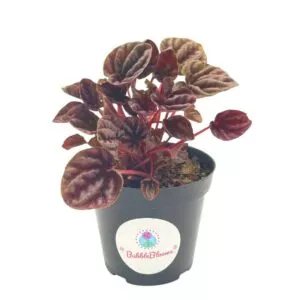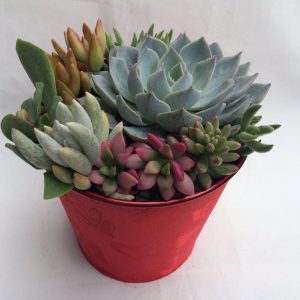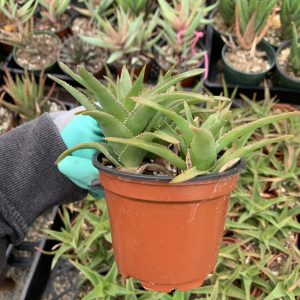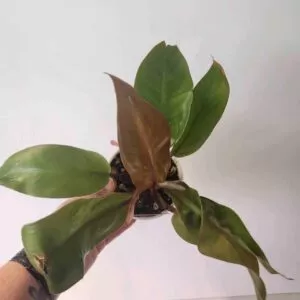No products in the cart.
Table of Contents
Prayer plants can brighten up your dull house or office in no time. Another popular tropical plant is the Maranta family.
Interestingly, these plants are named after an Italian physician and botanist, Bartolomeo Maranta, who lived in the 16th century.
Another reason why this is such a fascinating plant is that its leaves fold up at night to open up again in the morning.
So, if you already have these plants or need one, we will help you care for this unique plant.
Do not mix up Maranta and Calathea. Although both plants belonged to the Marantaceae family, they are of different genera. While both exhibit the characteristic of their leaves folding at night, it’s important to note that they are distinct plant species.
To clear up any confusion, read our article Maranta vs. Calathea: What’s The Difference for a comprehensive explanation.
More About Maranta
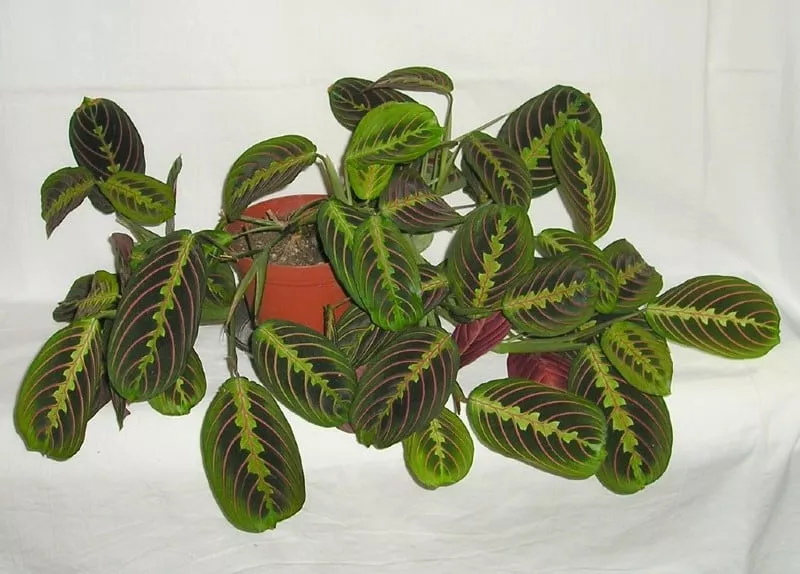
Maranta are evergreen and grown mostly as indoor plants as they provide stunning decorations to the home decor. The tricolor variety has deep green leaves with a velvety touch decorated with yellow splotches.
The maranta family foliage also has arching red veins that run down the leaf margins. Many people also call it the herringbone plant, and they are slow growers. The root system grows well in shallow pots.
The bright red veins stand out, and if you are lucky, you get white two-lipped blossoms with purple dots growing on short spikes in late spring to early summer. Unfortunately, houseplants are rarely seen with them.
The tiny flowers are pleasing to the eye, yet they are not the plant’s main features. This houseplant looks fantastic in a hanging basket or perched in just about any place. It’s a low-maintenance plant ideal for compact settings, so it’s the right plant for you!
Identifying and Addressing Issues
Symptom: Curling leaves with brown tips
Cause: Insufficient humidity
Symptom: Washed-out coloring or brown blotches on leaves
Cause: Excessive direct sunlight
Symptoms: Yellowing leaves, rotting stems
Cause: Overwatering
Maranta Care Basics
Maranta plants prefer greenhouse conditions that include warmth, moisture, plenty of fertilizer, and adequate ventilation. The low-growing plant does best in bright, dappled light and needs well-draining soil. It is a slow grower with colorful leaves and leaves the excess water drain from the pot to prevent root rot.
Still, while it needs enough light, direct sun can leave a washed-out look on the leaves.
But you need not feel threatened; we will learn slowly about this plant by knowing its overview first. We’ve provided them below:
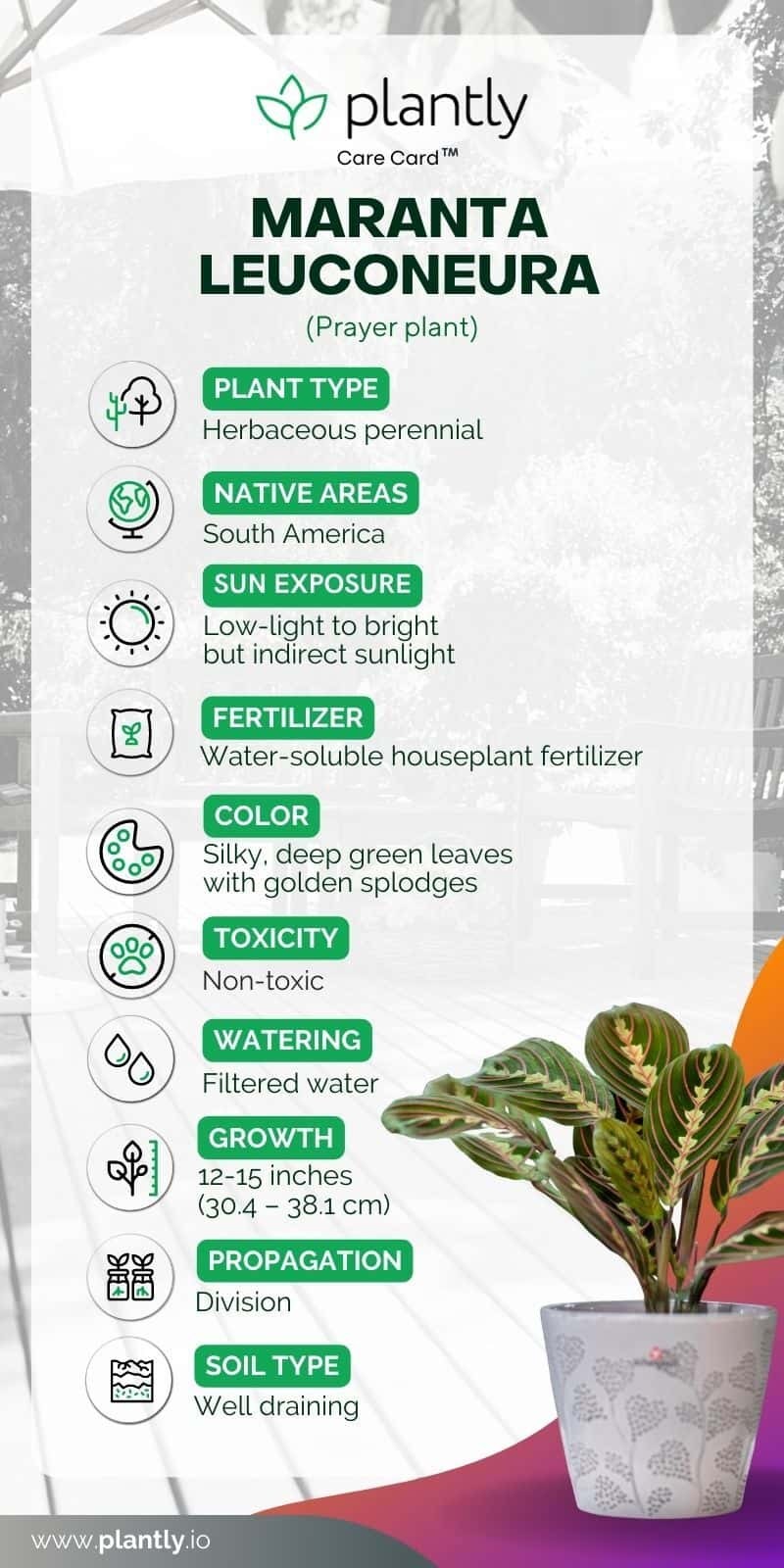
Soil
You can use any general-purpose houseplant potting soil if it drains efficiently. Yes, that’s right! The soil of your plants should be kept damp but not soggy. A typical potting mix will usually suffice, but you can always prepare your own!
Here’s what you will do:
Mix two parts: sphagnum peat moss, one part loamy soil, and one part perlite or coarse sand. Adding perlite or coarse sand promotes drainage and lining your pot’s bottom with rocks or gravel.
Be sure that the bottom of the pot has enough drainage holes. This potting soil will help retain moisture levels and is well-draining to keep the soil moist and allow excess water to drain from the pot.
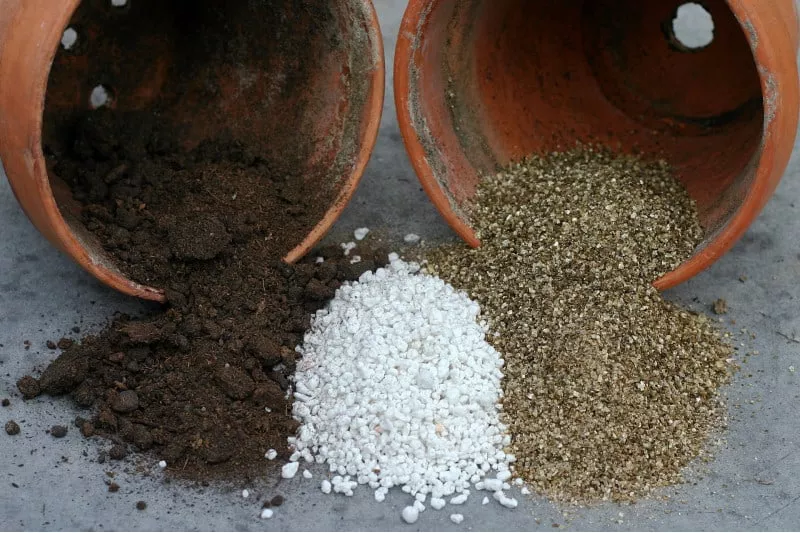
You could also use pre-packaged potting soil to ensure sufficient drainage before settling. In addition, plant maranta in soil that is mildly acidic. They prefer a pH of 5.5 to 6.
Water
Understand that maranta do not like to be dry if you want to cultivate them successfully. Ensure the soil is in stable moisture condition, but never allow the soil to become soggy. The leaves might turn yellow and drop due to a lack of water and overwatering.
And be sure to moisten the soil and not the leaves. To avoid fungal concerns, the plant’s leaves should always be dry (except for a few light veils of mist each week). While watering your maranta, you should do it frequently in its growing season and less frequently during its dormancy.
These plants are also particular when it comes to the water they drink. We recommend using:
Rainwater
Filtered Water
Distilled water
These are the preferred methods of watering and left at room temperature. If you must use tap water, we recommend leaving it for 24 hours to allow the chlorine to evaporate.
Lighting condition

During the day, it enjoys bright but indirect sunlight. Maranta plants are also generally tolerant of lower light levels with adequate airflow. The leaves will not be fully open during the day without light.
Too much sun, however, will cause faded colors, brown leaf spots, and leaf burn. Your maranta needs a sunny location near a window to obtain bright but indirect light. You could use a sheer curtain or something similar to shelter it from too much light.
To keep them growing, provide bright light to the plants over the winter when they go into hibernation (and sometimes die back completely).
Temperature

The average household temperature should be 60 – 80 degrees Fahrenheit (15.5 – 26.6 degrees Celsius). Please provide them a warm, moist, soft atmosphere with plenty of air circulation.
Lower temperatures for an extended period might harm the leaves, causing them to fall off the plant. Please keep it in a draft-free environment, especially during the winter months.
Thus, a considerable number are direct sunlight and cold drafts. Remember, maranta plants do best in bright indirect light for the gorgeous foliage to remain vivid.
Humidity
To grow maranta plants, they need highly humid environments. You will notice brown tips on the leaves when the air is too dry.
When the temperature rises above 65°F (18.3 degrees Celsius), or when the air is typically drier indoors in the winter, boost the humidity.
They prefer a humid environment, so a light misting will make them happier. Or you can place a small humidifier around or place the plant atop a tray packed with small stones and water to increase the humidity of your plant.
This will keep the leaves lush and vivid. If you have a bright bathroom, the mist from the shower will provide high humidity to the air, making it an ideal location for your existing plant.
Fertilizer

Fertilize your maranta plant every two weeks in the early spring and summer (once a month in the winter) using a half-strength water-soluble houseplant fertilizer.
It’s critical to give your plant the appropriate amount of food if you want it to survive because any imbalance has negative consequences.
Too much fertilizer will cause the roots to burn, the leaves to brown, and eventually die. On the other hand, plants that receive insufficient fertilization will grow slowly or not at all.
Propagation
Maranta propagation is a straightforward technique to expand your collection and employ larger mother plants.
The easiest way to propagate Prayer-plants is to divide them when repotting them. If your plant is vigorous and flourishing, it’s an excellent choice for division.
Divide your plant into several smaller plants before repotting it by gently brushing the soil from the roots and splitting them apart.
Ensure that each new plant has a healthy root system and many stems.
These new tiny plants should be potted separately in shallow pots as they have fewer roots than other plants. Hence, they will grow shallow roots.
Keep divisions warm and moist during the first few weeks until new growth begins in bright yet dappled light from direct sunlight.
Another method is using stem cuttings. When you take stem cuttings, dip them in a rooting hormone to place them in fresh soil. As with the parent plant, ensure the pot has a large drainage hole for excess water to drain and prevent root rot. If you feel the soil dry, then water. Ensure that it has well-draining soil.
Growth Zone
Maranta can be cultivated outdoors in protected settings in moist, humusy, well-drained soils in part shade to full shade in USDA Zones 11-12. It is also grown as a houseplant in St. Louis.
Marantas are found on the forest floor in tropical rainforests, revealing how they should be cared for.
Potting
Maranta thrive in small pots and look fantastic as they pour over the sides. A pot that is too big will have a lot of extra soil. That excess soil will retain too much moisture, producing problems for your plant later.
So, bigger pots are a big no-no to your Maranta. Before changing the pot’s size, ensure the plant has filled it with roots; otherwise, you may risk damaging your plant’s health. Remove the plant from its old container in the early spring, before the new growing season begins.
Gently shake and brush the roots clean with your fingertips. Then, using fresh potting soil, place it in the new container.
Pruning
Pruning Prayer-plants isn’t that necessary. However, it can significantly change how full and healthy your plant looks. You can prune your maranta if you want it to grow more vigorously.
Cut the stems with a sterilized pair of garden scissors just above a leaf node. This outdoor plant will then respond by sprouting new shoots beneath the clipped location, giving it a bushier appearance.
Maranta Leuconeura Varieties
Maranta is a low-growing plant in the Maranta genus. This plant comes in a few prayer plants, each with its leaf pattern and hue.
And here’s the catch: they all require the same level of attention! Some of them are listed below:
Red Maranta leuconeura ‘erythroneura’
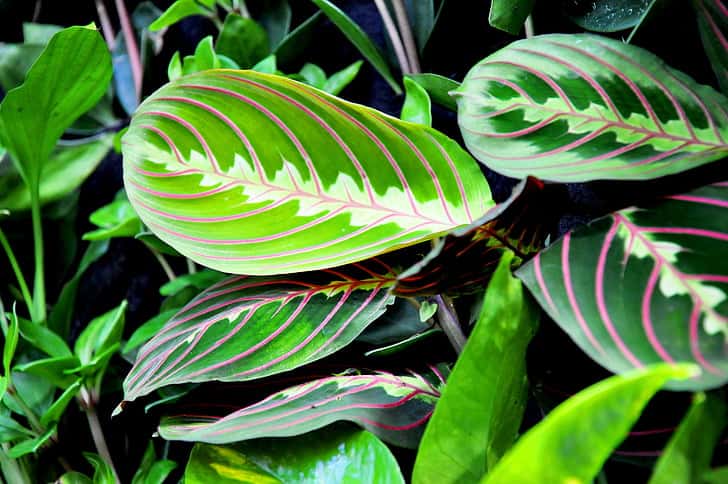
The leaves of the Red maranta are dark green with purple spots and deep crimson veins. In the evening, this plant’s leaves lift and fold up, then close in the morning.
Green Maranta leuconeura ‘Kerchoveana’

The Green maranta has oval leaves that are green-grey in hue with darker green-to-brown spots on the surface. On the other hand, these hues and the vein arrangement are not apparent from the back.
Maranta leuconeura var. leuconeura
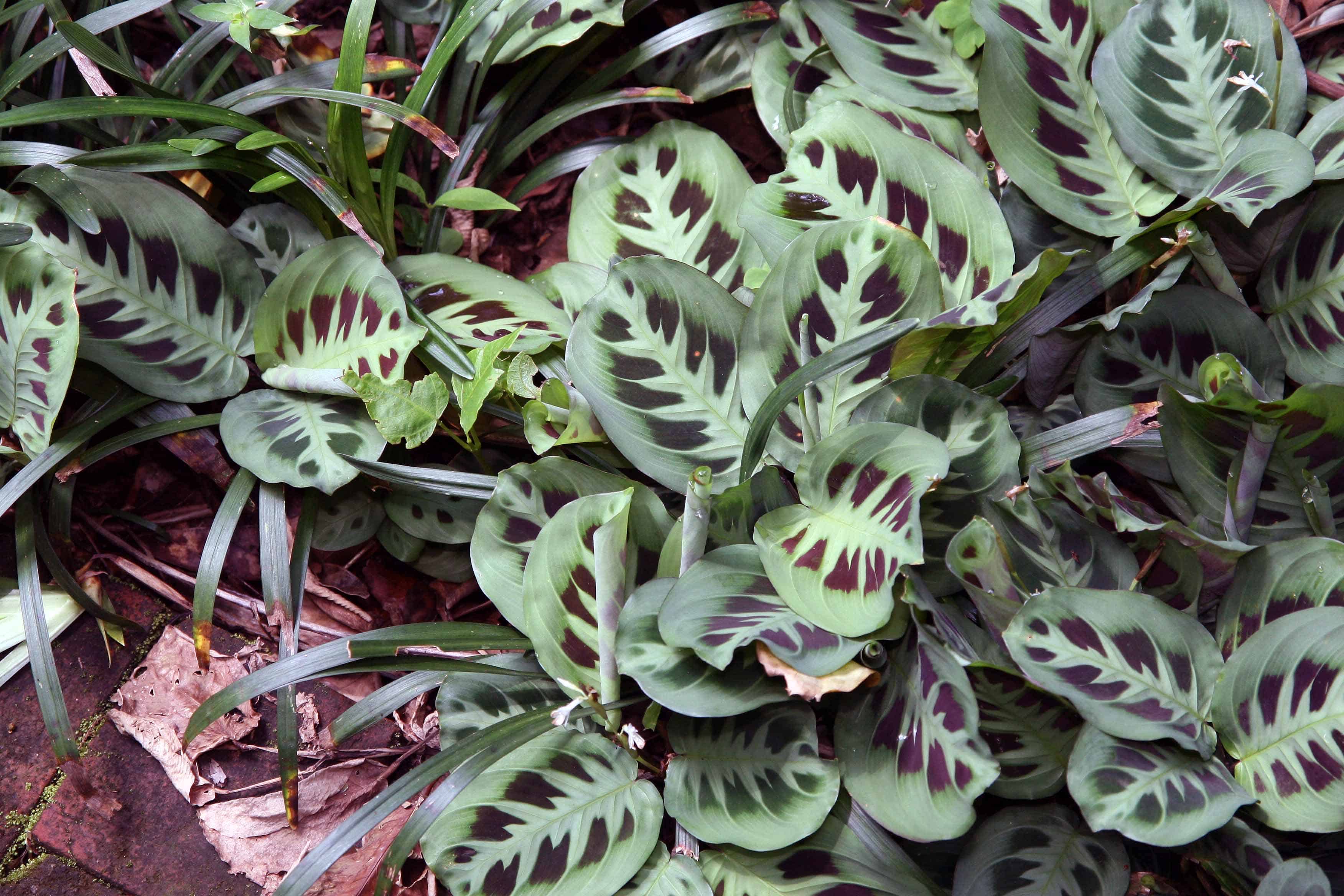
The silvery-blue foliage with rich olive-green borders and purple dots set it apart. It grows up to eleven inches tall and has tiny white flowers.
Marantha Diseases & Pests
Spider mites are the most prevalent household plant pests that attack plants. Nevertheless, an infestation is improbable if you keep your plant at the proper humidity level. Keep an eye out for spider mite infestations’ distinctive webbing.
If mites occur, neem or other plant-based oils can help eliminate them. Botanical oils on the leaf surface suffocate larvae and prevent adult insect instars from breathing.
Helminthosporium leaf spot that affects the plant is a fungal disease. This is commonly observed when there is too much standing water. It is critical to water the plant properly only at the base.
Remove any standing water and avoid getting the leaves too damp. This ailment will be treated with neem oil, which will also assist in preventing future infections.
Frequently Asked Questions
The prayer-plants of the Mantra family, with their beautiful green leaves, are not toxic to humans or pets. But still, if you do have curious animals, we recommend keeping your plant’s leaves away from them.
The prayer plants a slow growers and can reach 12 inches when mature. Prayer plants prefer being slightly root-bound as well and do not need repotting often.
These tropical beauties can grow indoors, but they need a humid environment similar to their native habitat.
Both plants are closely related and have the same name, prayer plants. But the calatheas leaves do not close at night but can move in an upward position. The marantas leaves, on the other, will close up at night and open up flat in the morning.
The calathea leaves you find can be round, oblong, lance-shaped, or oval, while the maranta leaves are oval.
The name prayer plants is because the leaves move upward at night, looking like praying hands. The maranta, on the other hand, has leaves that close up completely at night.
Whether you want to buy, sell or simply reach out to other plant enthusiasts, Plantly is the right place to be!
In stock In stock In stock In stock
$15.99
Sold By:
BubbleBlooms
Red Emerald Ripple Peperomia, Emerald Ripple Pepper, Red Platinum, Ivy-leaf Peperomia, Green Ripple, Peperomia caperata Yunck, 4 inch
Only 3 available and it’s in 1 people’s basket Rated 4.81 out of 5 based on 279 customer ratings02
Sold By:
BubbleBlooms
$43.99
Sold By:
Succulent Oasis
Large Succulent Arrangement in a Red Heart Patterned Fabric Covered Planter. Beautiful, completely assembled dish garden.
Rated 4.84 out of 5 based on 352 customer ratings00
Sold By:
Succulent Oasis
$11.00
Sold By:
Cacti and Exotica
Aloe ciliaris—climbing Aloe
Only 8 available and it’s in 1 people’s basket Rated 4.98 out of 5 based on 59 customer ratings00
Sold By:
Cacti and Exotica
$10.00
Sold By:
Stripes and Variegations
Philodendron Selloum – Sun Red Philodendron 4″ Pot
Sold By:
Stripes and Variegations
